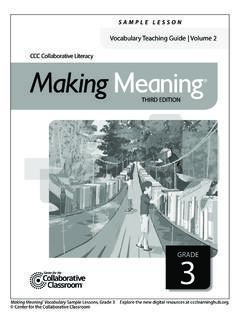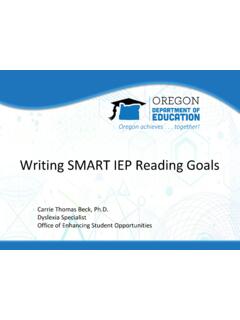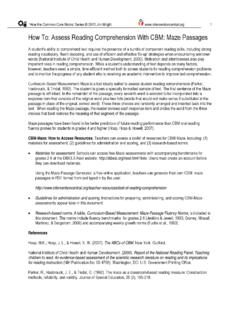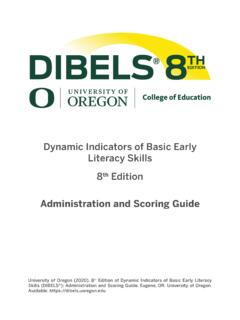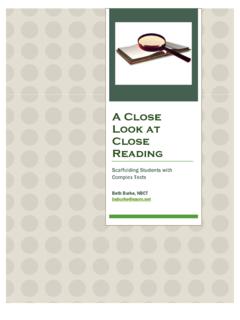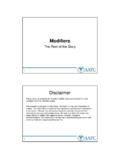Transcription of ASSESSING READING: MULTIPLE MEASURES
1 ASSESSING reading : MULTIPLE MEASURESA ssessing ReadingMultiple MeasuresEdited by Linda Diamond and ThorsnesCORE LITERACY LIBRARYREVISED SECOND EDITIONO akland CaliforniaArenaPressNovato California Arena PressA Division of Academic Therapy Publications Leveroni CourtNovato, California - - - on Reaching Excellence in Education, Inc. (CORE) Clay Street, Suite Oakland, California - - by Consortium on Reaching Excellence inEducation, Inc. (CORE). All rights publication contains copyrighted material. Purchasersof ASSESSING reading : MULTIPLE Measuresare granted permis-sion to reproduce pages for classroom use where permissionhas been stated. However, no part of this publication may bestored in a retrieval system, transmitted, or posted onlineeither for public or internal use, in any form or by any means,electronic, mechanical photocopying, scanning, recording, orotherwise, without prior written permission from permission requests, contact - - - - Print Number: Library of Congress Control Number: C R E D I T SEditorial: Linda Gutlohn, Shelle EptonContributors: Orna Lenchner, Jacalyn Mahler, Michael MiloneBook Design: Lucy NielsenA C K N O W L E D G M E N T SFor each of the following selections, grateful acknowledg-ment is made for permission to adapt and/or reprint originalor copyrighted Therapy Publications.
2 Critchlow Spanish Verbal Language Scales excerpted from Dos Amigos Verbal LanguageScales by Donald E. Critchlow. Copyright by AcademicTherapy Publications. All rights reserved. Reprinted by permission of the W. Howell: MASI-R Oral reading Fluency Mea-sures passages excerpted from Multi-Level Academic SkillsInventory, Revisedby Howell, M. K. Hosp, J. L. Hosp,and M. K. Morehead. Copyright by Kenneth All rights reserved. Reprinted by permission of theauthor. International Dyslexia Association: Assessment-DrivenInstruction: A Systems Approach by Linda Diamond inPerspectives, Fall ,pages . Copyright bythe International Dyslexia Association. All rights by permission of the reading Association: San Diego QuickAssessment of reading Ability excerpted from The GradedWord List: Quick Gauge of reading Ability by Margaret La Pray and Ramon Ross in Journal of reading , Vol.
3 , No. , January .Copyright by M. H. La Pray and theInternational reading Association. All rights by permission of the O N T E N T SIntroduction to ASSESSING reading .. Effective reading Assessment Systems.. Types of Assessment .. Assessment Sequence for Students in Kindergarten Grade 3.. Assessment Sequence for Students in Grades 4 12.. Diagnostic Plan for Students in Grades 2 3 .. Diagnostic Plan for Students in Grades 4 12.. M U L T I P L E M E A S U R E SCORE Phonological Segmentation Test .. Part A: Sentence Segmentation Part B: Syllable Segmentation Part C: Phoneme SegmentationCORE Phoneme Deletion Test .. Part A: Initial Phoneme Deletion Part B: Final Phoneme Deletion Part C: Deletion of Initial Phoneme in a Consonant BlendCORE Phoneme Segmentation Test.
4 CORE Spanish Phonemic Awareness Test .. Phoneme Oddity #1 Phoneme Oddity #2 Phoneme DeletionCORE Phonics Surveys .. CORE Phonics Survey (English) CORE Spanish Phonics Survey CORE Graded High-Frequency Word Survey .. San Diego Quick Assessment of reading Ability .. Decoding and Word RecognitionPhonological AwarenessCORE Spanish Spelling Inventory .. MASI-R Oral reading Fluency MEASURES .. CORE Vocabulary Screening Test .. Critchlow Spanish Verbal Language Scale .. CORE reading Maze Comprehension Test .. A P P E N D I XCORE ASSESSING reading Student Profile Forms(Kindergarten Grade 12) .. A CORE ASSESSING reading Class Record Forms(Kindergarten Grade 12) .. A Assessment-Driven Instruction: A Systems Approach .. A by Linda Diamond reading FluencyVocabularyComprehensionSpellingFo r Printable PDFs of the Student Profileand Class Record Forms,go to WHAT This phonological segmentation test contains fourparts that are arranged in order of difficulty: Part A: SentenceSegmentation, Part B: Word and Syllable Segmentation, and Part C:Phoneme Segmentation.
5 WHY These tasks may help to determine whether deficitsin phonological awareness account for the student s reading orspelling delays. According to research, the lack of phonologicalawareness is the most powerful determinant of the likelihood of a student s failure to learn to read. HOW Use the following Practice Items to demonstrate eachof the phonological segmentation tasks in Parts A, B, or C. Proceedto the Test Items only after the student demonstrates understand-ing of the tasks. When teaching a task using the Practice Items,praise the student for even close approximations of the correctresponse. However, when administering the Test Items, give onlygeneral feedback. Do not indicate whether a response was corrector OF .. Phonological AwarenessSkills AssessedSentence SegmentationSyllable SegmentationPhoneme SegmentationGrade LevelK Grade 1 PurposeScreeningProgress MonitoringDiagnosticLanguageEnglishAdmin istrationIndividual Approximate Testing Time5 10 minutesMaterials 8 small colored blocks or cubes Teacher Record Form (p.)
6 23)AuthorOrna Lenchner, PhDCOREP honological Segmentation TestC O N T I N U E D A S S E S S I N G R E A D I N G C O R E P H O N O L O G I C A L S E G M E N T A T I O N T E S T 19 Begin this part by administering the following Practice ItemOn a table or desk, arrange eight different colored blocks in a the student: John, what is something you like to eat?(pizza)Then say: I am going to use blocks to show the words in the sentence John likes pizza. As you say each of the words, select a colored block and move itout of the row. Use a different colored block for each word. Thenpointing to each block from left to right, ask: What is this word?(John) And this?(likes) And this?(pizza) If the student understands the task, ask him or her to do the taskindependently.
7 After putting the blocks back, say: Now it s yourturn. Use blocks to show the words in the sentence John likes pizza. TESTING PROTOCOL Proceed with testing when thestudent clearly understands the task. Discontinue testing if the stu-dent does not respond correctly to any of the first three Test Itemsin Part A. Breaking a word into syllables is not considered an A R T A Sentence SegmentationP A R T B Syllable SegmentationSENTENCE SEGMENTATION Given a sentence, studentshows a block for eachword in the this part by administering the following Practice ItemOn a table or desk, arrange eight different colored blocks in a to the student: Now we are going to break words into parts. I amgoing to use the blocks to show the wordcupcake. Say the word cupas you select the first block and move it out ofthe row.
8 Then say the word cakeas you select the second blockand move it to right of the first one. Use a different colored blockfor each : Which block is cup? (the first block)Point to the second block and ask: Which block is this? (cake)If the student still does not understand, it may help to clap the syl-lables. After putting all the blocks back in a row, provide additionalpractice using words such as superman, doorbell,or SEGMENTATION Given a whole word, student breaks the wordinto A S S E S S I N G R E A D I N G C O R E P H O N O L O G I C A L S E G M E N T A T I O N T E S TTESTING PROTOCOL Proceed with testing when thestudent clearly understands the task. Discontinue testing if the stu-dent does not respond correctly to any of the first five Test Itemsin Part A R T C Phoneme SegmentationBegin this part by administering the following Practice Item 1On a table or desk, arrange eight different colored blocks in a to the student: We are going to use the blocks to show the soundsin a word.
9 Let s say I wanted to show you the word time. The wordtimehas three sounds /t/ / / /m/. Select and move one block foreach of the sounds in timeas you say the sounds slowly in order,/t/ / / /m/.Use a different colored block for each : Can you say the three sounds in time? (/t/ / / /m/) If the stu-dent says letter names instead of sounds, say: Yes, that is how theword timeis spelled, but I want you to tell me its the student cannot independently say the sounds, repeat thesounds and ask: Can you point to the block that stands for /t/? Andwhich block stands for /m/? And what sound does the middle blockstand for? (/ /) Then ask the student: Can you say the three soundsin time? (/t/ / / /m/)Practice Item 2 After rearranging all the blocks in a row, say to the student: Nowyou try one.
10 If you wanted to show the word shop, how many soundsis that? (three) Use the blocks to show the student cannot segment the three sounds independently,model the task as :The word shophas three and move a block for eachof the sounds, as you say each sound in left-to-right progression,/sh/ /o/ /p/. Ask: What are the three sounds in shop?(/sh/ /o/ /p/)Which block stands for /sh/? (the first block) Which block standsfor /p/? (the last block) What sound does the middle block standfor? (/o/) If the student shows four blocks, he or she is probablytrying to spell the word. Remind the student to pay attention tothe sounds in the word, not the letters. PHONEME SEGMENTATION Given a whole word, student separates theword into individualphonemes and says S S E S S I N G R E A D I N G C O R E P H O N O L O G I C A L S E G M E N T A T I O N T E S T 21 TESTING PROTOCOL Proceed with testing when thestudent clearly understands the task and can at least point to theblock that represents the correct sound.
